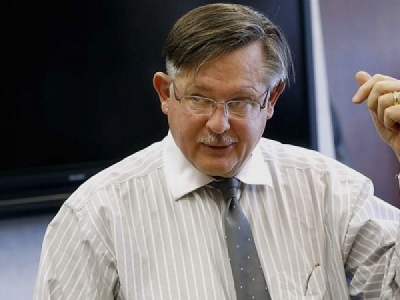
Posted on January 16, 2018
By Tom Henry, The Blade
For 34 years, Kurt Erichsen has been on the front lines of northwest Ohio’s biggest water issues.
Now, as he prepares for retirement on Jan. 31, officials are wondering how to fill the void he’ll leave behind.
“Kurt has 34 years of experience, but about 100 years of knowledge and passion for our region,” said Tim Brown, Toledo Metropolitan Area Council of Governments president. “He’s been in the trenches, hands-on making a difference. I characterize him as a brilliant man. He is a very smart individual.”
Mr. Erichsen isn’t a household name. He’s vice president of water quality planning for TMACOG, an agency that promotes regional thinking.
The world of planning isn’t as glamorous or headline-grabbing as activism. Planning is what those skilled at transportation and development issues do. Their mission is to help public officials shape our landscape through wiser decisions, striking a balance between economic growth and environmental protection.
Mr. Erichsen has been a quintessential behind-the-scenes player, and it is “behind-the-scenes stuff that makes a difference in government,” Mr. Brown said.
“He’s one of a kind in my career,” he said.
Mr. Erichsen’s decision to retire at age 63 was made easier because of a combination of health problems. A battle he’s had with Parkinson’s disease now includes spasms with his eyelids, making him sensitive to bright office lights.
“This has been a big piece of my life,” Mr. Erichsen said of his job. “It’s hard to walk away from that.”
He grew up in Coos Bay, Ore., and after getting his bachelor’s degree in civil engineering from Oregon State University, he received a master’s degree in sanitary engineering at Michigan State University.
Mr. Erichsen moved to Toledo for a job at Jones & Henry Engineers Ltd., then got hired by TMACOG in 1984 to promote bicycling and sewage treatment.
He found himself immersed in what has become a decades-old cleanup of Toledo’s Ottawa River, a waterway that was once Ohio’s most polluted.
Cancer-causing industrial pollutants became embedded in river sediment after leaking out of a mile-long corridor of waterfront landfills between Stickney Avenue and Lagrange Street. Getting public officials to acknowledge the problem was no small task, Mr. Erichsen recalled.
In 1987, the Maumee River watershed, which includes the Ottawa, became one of 43 ecosystems the International Joint Commission designated as “areas of concern” under the Great Lakes Water Quality Agreement the United States and Canada had signed in 1972. That designation helped get the Ottawa River cleanup moving, Mr. Erichsen said.
Many, though not all, of those pollutants were removed during a massive dredging project years later.
The U.S. Environmental Protection Agency said remaining pollutants are being covered over by clean sediment as it flows toward the river’s mouth, gradually bringing the river back to health.
Bottom line: The Ottawa is unquestionably better than it was when Mr. Erichsen came to Toledo in 1984, and it continues to improve. Like many other people, he’s been engaged in the ongoing fight against western Lake Erie’s toxic algae, too.
But Mr. Erichsen believes one of his biggest contributions has been working with rural communities on a regional effort for more and better sewage treatment. Problems with failing septic systems have been largely overlooked for years, he said.
Cherie Blair, Ohio EPA Maumee Area of Concern coordinator, said his work has “contributed to the health and improvement of water quality across northwest Ohio.”
Mr. Erichsen’s passion for environmental planning wasn’t his first calling in life, though. He was fascinated with drawing since he was young. He might have pursued a career as an illustrator if his parents hadn’t convinced him otherwise, but he never gave up his passion for drawing.
From 1980 to 2008, he produced a comic strip called “Murphy’s Manor.” It focused on the lives of gay men living in the fictional town of Black Swamp, Ohio. That series and others he produced, including “The Sparkle Spinsters” and “GLIB Talk,” appeared in as many as 70 publications marketed to homosexuals, resulting in awards from the Gay/Lesbian Press Association.
“I was trying to be entertaining while making a point,” Mr. Erichsen said.
Mr. Erichsen also has produced artwork for fans of science fiction fanzines and conventions. In 2015, according to Wikipedia, he was a featured panelist at the first Queers & Comics conference, lauded as one of the “Pioneers of Queer Men’s Comics.”
He and his partner, John Widmer, were married in Illinois that year. Mr. Erichsen said his plans include 15 new comic strips to go with an anthology featuring his past strips.
“It’s part of me and something I couldn’t put down,” Mr. Erichsen said of his hobby. “This is part of my being.”
Lucas County Commissioner Carol Contrada, TMACOG immediate past chairman, said Mr. Erichsen has an encyclopedic mind and is “a master of the practical and the profound.”
“He gets that the work is in the details,” she said. “When I learned he was an artist, it made sense to me. He has an artist’s perspective: taking care, attention to detail, and a sense of humor.”
Source: The Blade





